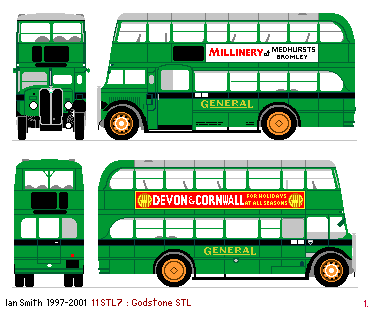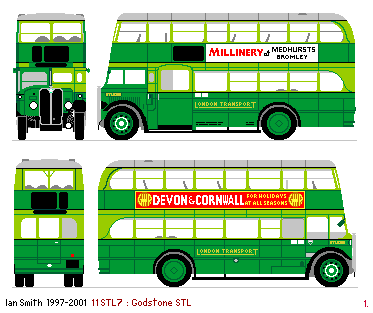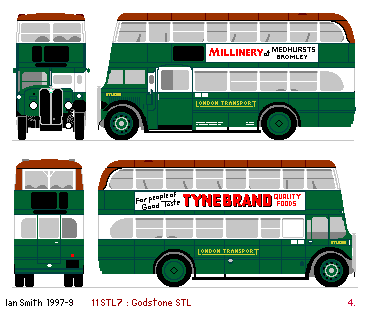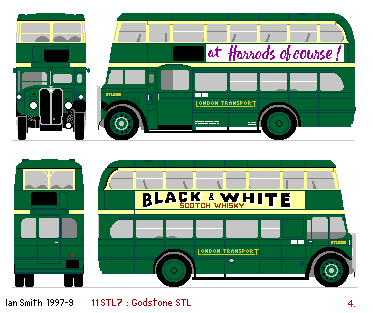
This page created 1997, updated 18th December 2001.
The Godstone STLs
|
STL 1044-1055 Godstone STLs (Total 12) 11STL7 These STLs were ordered by London General Country Services for use on 410 route
(Reigate -Redhill - Oxted - Westerham - Biggin Hill - Bromley (North Station)), which had a low bridge at Oxted,
following unsuccessful trials with LT single deckers.
(It is possible that London Transport was considering a batch of forward entrance low-height Renowns
for this duty, but changed its mind,
as a batch of 12 Renown chassis with offside-only fuel tanks was ordered just before these STLs).
These STLs were ordered by London General Country Services for use on 410 route
(Reigate -Redhill - Oxted - Westerham - Biggin Hill - Bromley (North Station)), which had a low bridge at Oxted,
following unsuccessful trials with LT single deckers.
(It is possible that London Transport was considering a batch of forward entrance low-height Renowns
for this duty, but changed its mind,
as a batch of 12 Renown chassis with offside-only fuel tanks was ordered just before these STLs).
They were built by Weymanns of Addlestone, and incorporated many features unique to London buses. Their low-height - 13ft 1in - was truly remarkable, especially as it was NOT a low-height, low-floor chassis. They achieved this by means of a sunken offside gangway upstairs, with 26 seats there arranged in alternate rows of three and four. The buses had a forward entrance - WITH DOOR - with a matching forward staircase behind the driver. (The doors would not have been permitted on Central Area buses, due to the policing restrictions on London bus design, but these buses only impinged on the Metropolitan Police Area at Bromley.) Another London-unusual feature (but shared with the Country "Scooters") were the glass louvres over the opening windows, to shed drips. These were replaced in due course by metal rain-strips. The 410 route possessed not only a low railway bridge but the fearsome Westerham Hill, where the buses had to climb the steep south-facing scarp of the North Downs. To tackle this the "Godstones" were given a 8.8 litre diesel engine, driving through an AEC crash gearbox WITHOUT a fluid flywheel.
Delivered to London Transport in May 1934, they had green and black livery
with silver roofs and General fleet-names. Wheels were painted orange initially, but quickly looked dirty and were repainted a more sensible colour. Into service They worked almost exclusively on the 410, (Bromley - Biggin Hill - Westerham - Godstone - Bletchingley - Redhill - Reigate) from Godstone (GD)
and Reigate (RG) garages. There were no spare bodies to allow for overhaul, but a whole spare bus, so
a couple worked briefly at Watford (WA) on the 336 during 1936 and 1937,
and one was allocated to Crawley (CY)
for use on the 434 between Crawley and Roffey Corner from July 1937.
They worked almost exclusively on the 410, (Bromley - Biggin Hill - Westerham - Godstone - Bletchingley - Redhill - Reigate) from Godstone (GD)
and Reigate (RG) garages. There were no spare bodies to allow for overhaul, but a whole spare bus, so
a couple worked briefly at Watford (WA) on the 336 during 1936 and 1937,
and one was allocated to Crawley (CY)
for use on the 434 between Crawley and Roffey Corner from July 1937.
In 1937 the Country Area improved its fleet livery, with the introduction of a lighter green relief colour, the black bands becoming black lining. On the Godstone STLs the silver roof was continued to the rear too, instead of the painted rear dome section. The sidelights were brought down from the tween-decks band to below the cab front at about this time too.
War-time brought changes, of course. The 410 passed the front-line defence airfield of Biggin Hill.
So blackout precautions were quickly and rigidly enforced, and there were restrictions on the route past the airfield.
Only one bus was allowed to pass at a time, without stopping,
and with a sentry posted on the bus to prevent anyone getting off.
In 1941 the 410 was cut into two halves by security measures at Biggin Hill airfield
(where the main road went along the end of the main runway, as it still does).
As a consequence the northern part was operated by standard double-deckers from Dunton Green (DG)
giving rise to a temporary surplus of lowbridge STLs on the 410.
So STL 1052-5 were transferred to Watford
for use on the 336, in order to release four low-bridge STs for use
on the hard-pressed 127 route (Morden - South Wimbledon).
STL 1053 returned to Godstone when released by arrival of
STL 2148 at Watford in August 1942, followed by 1054 and 1055 in May 1944.
STL 1053 returned to the 410 at the same time, but working from Dunton Green.
STL 1045 also had a spell at Dunton Green from 1944 to 1946,
still working the wartime-restricted 410.
Well overdue for heavy overhaul after the war, the Godstones were worked over during 1948-49 by Chiswick, Reigate and Aldenham. The nine treated at Aldenham were repainted in green with cream upper window surrounds and a cream band. The bodies were found to be surprisingly sound. Some of their duties were taken over by Bristol K6A's and K5G's on loan from other companies, until arrival of the first of the RLH class, that supplanted them from Godstone and the 410, and all twelve spent two or three more years at other Country garages, such as Guildford and Addlestone. They had their displays remasked to be able to share the diminutive RLH blinds. 1953 saw four of them returned to service during June, when London Transport resurrected over 150 STLs to cope with the traffic generated by the Coronation. STL1052 was relicensed at Addlestone, and STL1053/1055 at Guildford, but STL1051 was a surprise at Garston. The resurrection was brief, and the buses were all taken out of service at the end of June, and despatched to North's at Leeds.
STL1055 found a further home in Yorkshire, and worked on for another couple of years.
|
 The buses lost their attractive two-tone green,
it being replaced with darker Lincoln green and white relief.
To be fair, the green colour change was not war-related but wear-related:
LT's engineers had been so worried about the way that the green was wearing quickly
to a shabby state that they had considered changing the whole Country fleet to red
- but found hard-wearing Lincoln green instead.
The buses lost their attractive two-tone green,
it being replaced with darker Lincoln green and white relief.
To be fair, the green colour change was not war-related but wear-related:
LT's engineers had been so worried about the way that the green was wearing quickly
to a shabby state that they had considered changing the whole Country fleet to red
- but found hard-wearing Lincoln green instead.

 bus histories
bus histories Ian's Bus Stop
Ian's Bus Stop STL index
STL index Country STLs
Country STLs Godstone STLs
Godstone STLs